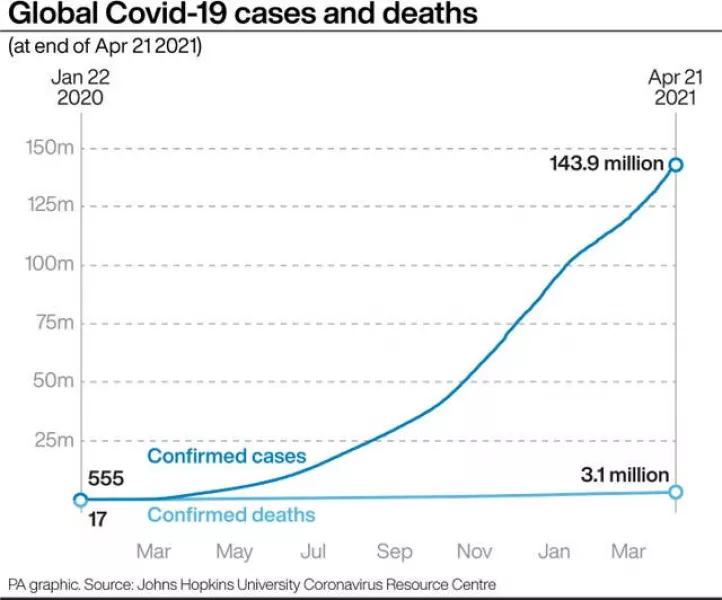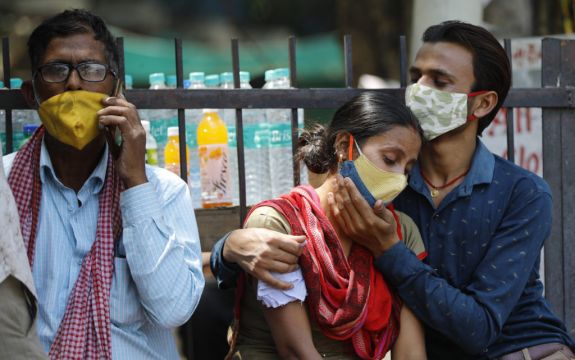The world’s fastest pace of spreading infections and the highest daily increase in coronavirus cases are pushing India further into a deepening and deadly healthcare crisis.
India is the world’s second-most populous country with nearly 1.4 billion people, and its size presents extraordinary challenges in fighting Covid-19.
Some 2.7 million vaccine doses are given daily, but less than 10% of its people have had their first jab.

Overall, India has confirmed 15.9 million cases of infection, the second highest after the United States, and 184,657 deaths.
The latest surge has driven India’s fragile health systems to breaking point: understaffed hospitals are overflowing with patients; medical oxygen is in short supply; intensive care units are full; nearly all ventilators are in use; and the dead are piling up at crematoriums and cemeteries.
– How did we get here?
Authorities were lulled into believing the worst was behind them when cases started to recede in September.
Cases dipped for 30 consecutive weeks before starting to rise in mid-February, and experts say the country failed to seize the opportunity to augment healthcare infrastructure and aggressively vaccinate.

“We were so close to success,” said Bhramar Mukherjee, a biostatistician at the University of Michigan who has been tracking India’s pandemic.
Despite warnings and advice that precautions were needed, authorities were unprepared for the magnitude of the surge, said K Srinath Reddy, president of the Public Health Foundation of India.
Critics have pointed to the government deciding not to pause Hindu religious festivals or elections, and experts say that these may have exacerbated the surge.
“Authorities across India, without exception, put public health priorities on the back burner,” Mr Reddy said.
Consequently, India’s seven-day rolling average of confirmed daily new cases has risen over the past two weeks from 6.75 new cases per 100,000 people on April 6 to 18.04 new cases per 100,000 people on April 20, possibly driven by new variants of the virus, including one that was first detected in India, experts say.
India’s top health official Rajesh Bhushan would not speculate on why authorities could have been better prepared, saying: “Today is not the time to go into why did we miss, or did we miss, did we prepare?”
– Why is India’s health system collapsing?
India only spends a fraction of its gross domestic product on its health system, lower than most major economies.

As the virus took hold last year, India imposed a harsh, nationwide lockdown for months to prevent hospitals from being overwhelmed. This brought terrible hardship to millions, but also bought time to implement measures to plug critical gaps, such as hiring additional healthcare workers on short-term contracts, establishing field hospitals and installing hospital beds in banquet halls.
But authorities did not take a long-term view of the pandemic, said Dr Vineeta Bal, who studies immune systems at the Indian Institute of Science Education and Research in Pune city.
Suggestions for permanent improvements such as adding capacity to existing hospitals or hiring more epidemiologists to help track the virus were widely ignored, she said. Now authorities are scrambling to resuscitate many emergency measures that had been ended once the numbers fell.
A year ago, India was able to avoid the shortages of medical oxygen that plagued Latin America and Africa after it converted industrial oxygen manufacturing systems into a medical-grade network.
But many facilities went back to supplying oxygen to industries and now several Indian states face such shortages that the Health Ministry has urged hospitals to implement rationing.
The government in October began building new plants to produce medical oxygen, but now, some six months later, it remains unclear whether any have come on line, with the Health Ministry saying they were being “closely reviewed for early completion”.
Tanks of oxygen are being shuttled across the country to hotspots to keep up with the demand, and several state governments have alleged that many have been intercepted by other states en route to be used to meet local needs.
– What comes next?
India is faced with the massive challenge of trying to prevent its healthcare system from further collapse until enough people can be vaccinated to significantly reduce the flow of patients.

The good news is that India is a major vaccine producer, but even after halting large exports of vaccines in March to divert them to domestic use, there are still questions of whether manufacturers can produce enough fast enough.
“Vaccination is one way to slow down the spread – but this really depends on the speed and availability of the shots,” said Mr Reddy, of the Public Health Foundation.
Already several states have said they have shortages in vaccines – although the federal government denies it.
India said last week it would allow the use of all Covid-19 vaccines that have been approved by the World Health Organisation or regulators in the United States, Europe, Britain or Japan.
On Monday, it said it would soon expand its vaccination programme from people aged over 45 to include all adults, some 900 million people – well over the entire population of the entire European Union and United States combined.
Meanwhile, Mr Reddy said some states have had to implement new lockdowns, but long term it was up to individuals as well to play their part.
“As a society, it’s crucial that we maintain public health measures like masking, physical distancing and avoiding crowds,” he said.







